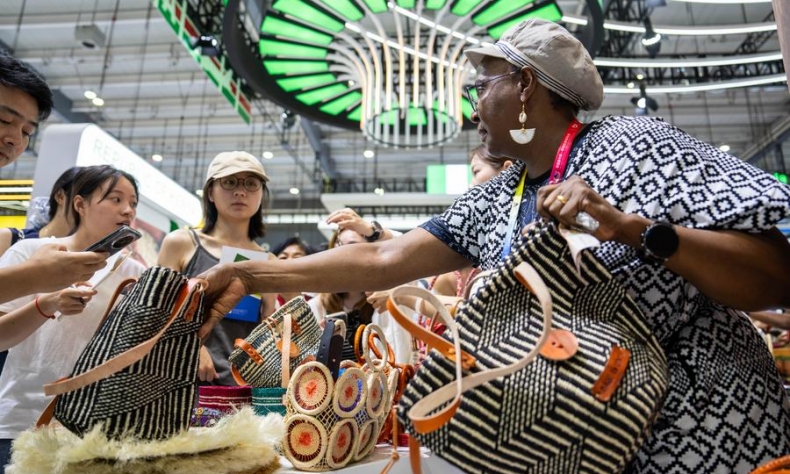Southern Synergy

China and Africa forge strong partnerships amid the rise of the Global South.
In an era of transformation of global governance architecture, the Global South has become an increasingly important focus in international relations. Historically, countries within the Global South have occupied a peripheral position in the global economic order, constrained by West-dominated financial, trade and technological systems.
However, in recent years, the emergence of new economies and the deepening of South-South cooperation have changed this reality. The Global South is gradually shedding its passive dependence on the West, showcasing their unprecedented development initiative and vitality. Against this backdrop, the collaboration between China and Africa stands out as a driving force not only for mutual development, but also for the broader resurgence of the Global South.
Despite the geographical distance between them, China and Africa share a long history of engagement. In ancient times, figures such as Du Huan of the Tang Dynasty (618-907), Ibn Battuta of Morocco, and the Ming Dynasty (1368-1644) navigator Zheng He set milestones in China-Africa exchanges. However, it was in the mid-20th century that large-scale interaction began in earnest. China actively supported African nations in their struggles for independence. A prime example is the construction of the Tanzania-Zambia Railway in the 1970s, a symbol of China-Africa solidarity.
Since the beginning of the 21st century, China-Africa relations have entered a phase of institutionalised cooperation. The establishment of the Forum on China-Africa Cooperation in 2000 marked a new era of friendly, cooperative and win-win engagement.
Solid economic ties
Economic and trade cooperation remains a central pillar of China-Africa relations. In recent years, trade between China and Africa has shown strong resilience and sustained growth. According to Chinese customs statistics, in 2024, total China-Africa trade reached a record 2.1 trillion yuan ($292.5 billion), an increase of 6.1 percent from the previous year. Notably, nearly half of African countries experienced double-digit growth in bilateral trade with China. Since 2000, the trade volume between China and Africa has risen with an average annual growth rate of 14.2 percent.
Previously, China-Africa trade largely revolved around the export of African energy and mineral resources to China and the import of Chinese manufactured goods. However, this traditional model is undergoing structural transformation. Trade is increasingly focused on high value-added sectors such as mechanical and electrical products, digital services and green technology. In 2024, China’s exports of smartphones, photovoltaic modules and industrial robots to Africa saw significant increases. On the African side, exports of processed agricultural products to China have seen significant growth, showing the continent’s potential in agro-processing and manufacturing.
At the same time, China has actively promoted its “going global” strategy, encouraging domestic enterprises to invest in Africa’s manufacturing, agro-processing, energy and digital economy sectors. This effort contributes to African industrialisation and strengthens self-reliant growth. African countries themselves are pursuing industrial upgrading and adjusting development strategies to increase the added value of their exports. The shift in China-Africa trade towards diversification, higher value-added and technology-intensive sectors is becoming more pronounced. In the future, the two sides are expected to deepen cooperation in sectors such as industry, agriculture, telecommunications, digital economy, green energy and finance.

Infrastructure cooperation is another cornerstone of China-Africa relations and a powerful engine for African economic and social development. By 2024, Chinese enterprises had helped African countries to build or renovate more than 10,000 km of railway, nearly 100,000 km of roads, close to 1,000 bridges and nearly 100 ports. Among the landmark projects is the Addis Ababa-Djibouti Railway, the first transnational electrified railway constructed by Chinese firms in Africa. Spanning over 750 km, it has significantly reduced Ethiopia’s transport time to port and lowered logistics costs. Similarly, the Chinese-built Lekki Deep Sea Port is set to transform Lagos into a key transhipment hub for West and Central Africa, with projected economic benefits of nearly $360 billion and 170,000 new jobs.
Beyond transport infrastructure, China has also invested in Africa’s energy sector, constructing hydropower stations, solar plants and transmission lines to alleviate electricity shortages. Projects in Zambia and Zimbabwe have improved energy stability and promoted sustainability. Simultaneously, the advancement of the Digital Silk Road has seen China assist African countries in developing mobile networks and data centres. These initiatives have expanded digital coverage and catalysed economic integration and digital transformation across the continent.
With these projects, China has delivered unprecedented opportunities to African nations. Improved infrastructure has enhanced connectivity, facilitated the flow of resources and boosted Africa’s capacity for independent development. Energy cooperation has supported Africa’s green transition and sustainability goals. Meanwhile, digital infrastructure has opened new avenues for growth in e-commerce, online education and smart cities.
Deepening friendship
China-Africa cooperation extends beyond economics into deep people-to-people ties, which are essential for the long-term stability of bilateral relations. Through education aid, medical assistance and cultural exchange, China has fostered strong emotional bonds with African peoples. Each year, the Chinese government offers a large number of scholarships to African students and promotes partnerships between Chinese and African universities. Confucius Institutes and Luban Workshops have helped to spread Chinese language learning and vocational training, serving as important bridges for mutual understanding.
In the health care sector, China has been sending medical teams to Africa since the 1960s. As of August 2024, China has sent 25,000 medical personnel to 48 African countries, treating approximately 230 million patients. Additionally, China has established partnerships with 46 hospitals in 41 African countries.
Cultural exchange has also flourished. Chinese media and enterprises have supported the digitalisation and capacity building of African media. Performances such as traditional South African dance Manyanano: The Spirit of Ubuntu in China’s Xinjiang Uygur Autonomous Region and the broadcast of Chinese TV dramas like Empresses in the Palace on African networks have deepened cultural familiarity. Events such as Spring Festival celebrations and China-Africa Youth Festival have become signature venues for artistic and cultural engagement.
China, now the world’s second-largest economy, plays an increasingly significant role in global affairs. Africa, in turn, is seeking to move away from dependence on aid and raw material exports, aiming for more autonomous and sustainable development. The synergy between China and Africa is not only a model of mutual gain, but also a powerful symbol of Global South cooperation. Together, they are writing a new chapter in the development narrative of the Global South.
Huang Jinkuan, Lecturer, Institute of African Studies, Zhejiang Normal University.
Guo Chuanxi,Research Assistant, Institute of African Studies, Zhejiang Normal University.
 Facebook
Facebook
 Twitter
Twitter
 Linkedin
Linkedin
 Google +
Google +










